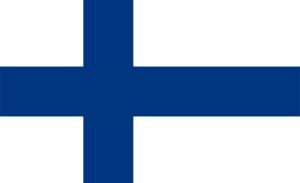
| Colors | HEX Code | RGB | CMYK |
|---|---|---|---|
| White | #FFFFFF | 255, 255, 255 | 0, 0, 0, 0 |
| Blue | #003580 | 0, 53, 128 | 100, 59, 0, 50 |
The Finnish flag is rectangular in shape and has a white field with a blue cross.
Meaning of the Finnish Flag
The white field on the Finnish Flag represents Finland with its snow and white landscapes. The blue color stands for the country’s water, as Finland is known as the land of “One Thousand Lakes.” The Nordic cross signifies Finland being a part of the Nordic community.
History of the Finnish Flag
Finland was a grand duchy in the 16th century ruled by Sweden. It had its own coat of arms. Then the rule was transferred to Russia in 1809. The flags of Sweden and Russia were used as the official flags. The colors of the coat of arms which are yellow and red became the national colors, and were raised in different versions of unofficial flags. In the 1840s, the Finns felt the need to have their own flag, and during the following decades, the blue and white gained popularity since they represented Finland’s snow and water. They were mentioned in a poem that later became the national anthem. On December 6, 1917, Finland proclaimed its independence from Russia. The red and yellow flag was raised on the day Finland became independent.
The flag had a crimson-red field with the golden lion featured in the coat of arms of Finland. The lion was armed in silver and rosettes of the same color were thrown around it. The blue and white flag was debated in the same year, and in 1918, the blue and white flag designed by Eero Snellman and Bruno Tuukkanen became official. The flag remains unchanged till now.